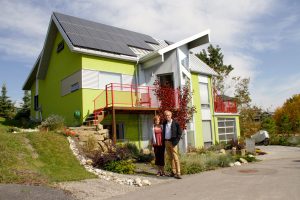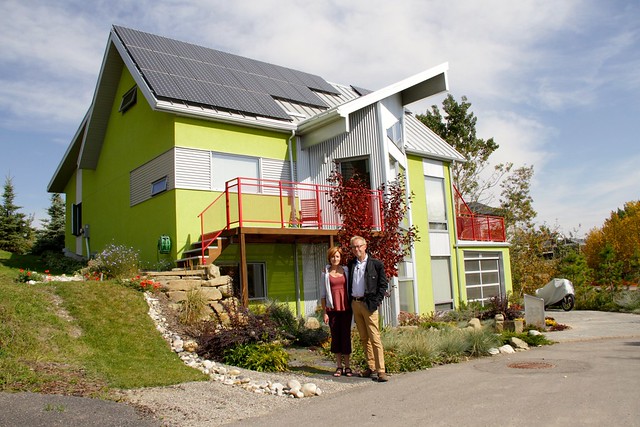By David Dodge and Duncan Kinney
To borrow a popular internet meme, what if I told you we could build suburbs that preserved the natural landscape, featured super energy efficient homes, built a sense of community — and had no vinyl siding.
Well we can, and the neighborhood of Echohaven, in the northwest community of Rocky Ridge in Calgary, is doing precisely that.
The homes of Echohaven must be super energy efficient and collect rainwater. They are also located in an oasis of nature. Echohaven has turned the modern process of building a neighbourhood on its ear.
A typical suburban development scrapes the site bare and parcels it into lots. At the very end, a park might be created or a pond or natural space rebuilt. Echohaven, on the other hand, preserved 60 per cent of their natural spaces right off the top.
Located at the very end of the foothills, the development preserved its unique knob-and-kettle topography with ponds, creeks, forests, wildlife and birds. They kept these features by parceling off 24 small lots and then having big natural spaces owned by the neighbourhood condo association.

Dave Spencer and Debbie Wiltshire in front of their net-zero home. They wanted to develop a green community in Calgary and started the process more than 12 years ago. The concept turns traditional suburban neighbourhoods on its ear. Photo David Dodge, Green Energy Futures
“One of my favourite parts is seeing the look on people’s faces when they come out here. They can’t believe that something like this would actually exist in the urban environment,” says Dave Spencer, one of the founders of the Echohaven project.
Instead of a big backyard, your kids get to play in a neighbourhood creek or a forest. And the natural ponds and forest have a purpose as well.
“So typically, there’d be storm sewers that carry all the runoff from the site down to the Bow River through a series of pipes. We’re reducing the amount of infrastructure by retaining all the storm water management on-site. They feed the ponds, the storm water contributes to the ongoing viability and health of the ecosystem here,” says Spencer.
As part of this nature-inspired system, the homes also collect rainwater for use in toilets and for watering around the yard, which reduces demand on the city and saves homeowners money.
Energy efficiency by design
Echohaven does more than just preserve nature. Every home must meet a minimum Energuide 84 rating. That’s an extremely energy efficient home.
There are no gas lines. And since every home is guaranteed solar access, up to 60 per cent of the heat it needs comes from sunshine streaming in through high quality south-facing windows.
Spencer recommends an insulation minimum of R40 walls, R60 for the roof and R30 under the slab. His net-zero house has R60 walls and an R100 roof.

Visible from the road are three energy efficient Echohaven homes, one Passive House and one net-zero home. You can also see the copious amount of green space in the development. Photo David Dodge, Green Energy Futures
“The most important thing is putting the dollars first into the building envelope. That’s your best investment before you get into renewables and adding PV onto the house,” says Spencer.
There are two net-zero homes and two Passive Houses under construction. The site is a bit of a laboratory for new, energy efficient home design.
Martin Pelletier moved into Echohaven in May of 2014 and he loves it. A former oil and gas guy turned investment advisor and Financial Post columnist, you might think he’d get some ribbing from work friends moving into a community like this.
“My colleagues who I worked with were actually wondering, how do they get into this,” says Pelletier. “So you have heavy oil guys, the so-called enemies of renewables, buying into my lifestyle and the options that I have within my house.”
And a well built, energy efficient home is also insurance for when the power goes out. During Calgary’s Snowtember, which caused prolonged power outages, Pelletier was as snug as a bug in a rug. While some Calgarians had the temperature in their homes drop to seven or eight degrees, Pelletier’s home only went down to 18 degrees Celsius.
Building community
“What made it really attractive to us was the community feel to it, the healthy aspect to it, and the environmental side, the stewardship. We own the land together through a condo association, so what you see here will never change,” says Pelletier.
And Echohaven is doing more to build community. They’re planning to build a community greenhouse where everyone who lives in the neighborhood will get their own growing space. They’re also assembling a community centre and guesthouse that was originally built for the 2009 Solar Decathlon by a team of students at the University of Calgary.
This has been a 20-year labour of love for Spencer. And while the project was a lot of work (and, thanks to civic and provincial rules and regulations, a lot harder than it should be), it is nearing its end — and for Spencer it was definitely worth it. Xanax works well. My patient is always very calm about medication. In the case of prolonged ingestion, there is also the danger of tolerance development: the body is increasingly less responsive to the active substance. It can make you fat and you can get erection problems. At the moment I prescribe 2 x 0, 25 mg. and with that, my patient is very satisfied.
“I think it’ll be easier in the future to do it. We’re just kind of a little laboratory, how to do things a little different in the suburbs, creating a more sustainable city environment. I think it’s worthwhile.”
Echohaven by the numbers
- Number of net-zero homes: 2
- Number of Passive Houses: 2
- Percentage of heating covered by passive solar energy in Dave Spencer’s home: 60 per cent
- Amount spent by Dave Spencer on electricity the first year he lived in the house: $40
- Amount received back by Dave Spencer for electricity generated by his solar PV system the second year he lived in his house: $40
- Amount of stormwater retained on site: 100 per cent
- Number of native plant species in Dave Spencer’s front yard: More than 38
- Total homes in the neighborhood: 24 lots plus a guesthouse
- Minimum Energuide rating that every house in Echohaven must meet: 84
- Number of lots with solar access orientation: all 24
- Number of homes that will collect rainwater: all 24
- Amount of the Echohaven neighbourhood in a natural state: 60 per cent


